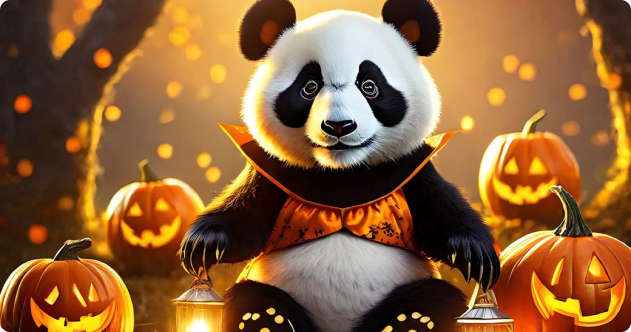
The History of Halloween and it's Branding
How it is branded to what it is today.
October 30, 2023 | Blog
Halloween ?️, the spooktacular, spine-tingling celebration that creeps into our lives every late October, has a history that's more thrilling than a ghost story by the campfire. What started as a mystical Celtic ritual called Samhain has taken a bewitching journey through time, evolving into the commercialized and creatively branded extravaganza we adore today. ??
A bit of history...
Halloween's roots go back to the ancient Celtic bash known as Samhain, a festival marking the end of the harvest season. On the night of October 31st, it was believed that the veil between the living and the dead was at its flimsiest, allowing spirits to wander among us. ??
During these ancient times, people lit bonfires and donned costumes as their ghostly disguises to keep those wayward spirits at bay (not to go around houses and ask for candy ?). They also carved turnips (not pumpkins) into spooky faces, displaying them in windows to ward off spirits ?.
Halloween was no plain pumpkin when it interacted with various traditions over the years. It collided with the Roman festival of Feralia, honoring the dearly departed, and the Christian holiday All Saints' Day, morphing into All Hallows' Eve, which eventually got its trendy abbreviation - Halloween.
With Irish immigrants flooding the U.S. in the 19th century, Halloween's popularity surged. It took on a secular and commercial character, adopting the costume-clad parades and the infamous trick-or-treating tradition we know and love today. As a result, marketing and branding turned Halloween into a holiday shopping spree. ??
As I mentioned, turnips were carved instead of pumpkins but when the Irish immigrants came to the U.S., they found out that pumpkins were more readily available to carve at the end of October (pumpkins are planted from May through June which makes them fully mature by October) which brings us to why the usual color scheme for Halloween is orange ?.
These pumpkins are also often called jack-o-lanterns and this involves an Irish and Scottish story of a character named Stingy Jack who was a notorious trickster that managed to outwit the Devil ? on multiple occasions. When Jack died, he was neither admitted to Heaven nor Hell. As a result, he was condemned to wander the Earth with only a burning coal inside a hollowed-out turnip to light his way. Fun fact, this is also where Jack Skellington from Nightmare Before Christmas got his name.

In today’s time, carved pumpkins are used to decorate houses for Halloween. Decorated houses usually means that the people who live there are giving out candies and goodies to kids who are trick-or-treating. With a bit of research, we found that there are not only orange pumpkins but different colors as well, that are used for awareness whilst in the hunt for goodies.
Here are some of them:
- Teal Pumpkin
This awareness campaign was started by the Teal Pumpkin Project, a Food Allergy Research & Education organization (FARE) initiative. This color means that the house has food-allergen-friendly options for trick-or-treaters. Similarly, if you see a child trick-or-treating with a teal-colored bucket, this means that the child has a food allergy. - Blue Pumpkin ?
An awareness campaign started by, Autism Speaks, blue pumpkins signify that the child inside the house isn’t participating in trick-or-treating and might be easily agitated by the ringing of the doorbell or it could also mean that the house supports trick-or-treaters who are within the spectrum. Similarly, kids with blue buckets mean that the child carrying it is on the autism spectrum and may need a grown up’s assistance to go trick-or-treating. - Purple Pumpkin ?
Launched by a parent of a child with epilepsy, the Purple Pumpkin Project seeks to raise awareness and money for the Epilepsy Foundation. A home with a purple pumpkin indicates support for the cause or that someone who lives has or knows someone that suffers from epilepsy. - Yellow Pumpkin ?
Houses with yellow pumpkins advocate and raise awareness for the disabled and at the same time, a child with a yellow bucket may signify that they need a little extra compassion.
If your brand wants to join the haunted hype this Halloween, here are some wickedly good tips to get you started:
- Themed Products and Promotions ?: Create Halloween-themed products, services, or promotions that'll enchant your audience.
- Engage on Social Media ?: Spook up your social media presence! Share eerie stories, costume ideas, and hold fang-tastic contests and giveaways.
- Collaborate with Influencers ?: Partner up with influencers who thrive during Halloween. They'll help you cast your marketing spell on a targeted audience.
- Decorate Your Space ?: If you've got a physical store or office, transform it into a Halloween wonderland. Attract curious souls and create an eerie atmosphere. ??
- Spooky Content ?: Serve up Halloween-themed content that's as thrilling as a haunted house tour. Share ghostly tales, how-to guides, and other content that engages your audience's spooky side.
- Charitable Initiatives ?: Consider tying your brand to charitable initiatives during Halloween. Show your commitment to the community and create a brand image that's sweeter than a sack of candy! ??
Halloween is a howling good time with a history as intriguing as a ghost hunt in a creepy mansion. The symbolism of differently colored pumpkins adds a delightful twist, offering endless possibilities for marketers. By adopting a bewitching branding strategy, your brand can cast a spell on audiences and become part of this ghoulishly grand celebration. ??
Subscribe to our newsletter
Gain access to helpful tips, tricks, trends and stats that can help you elevate your brand’s digital presence. We also send exclusive discounts to our subscribers.
